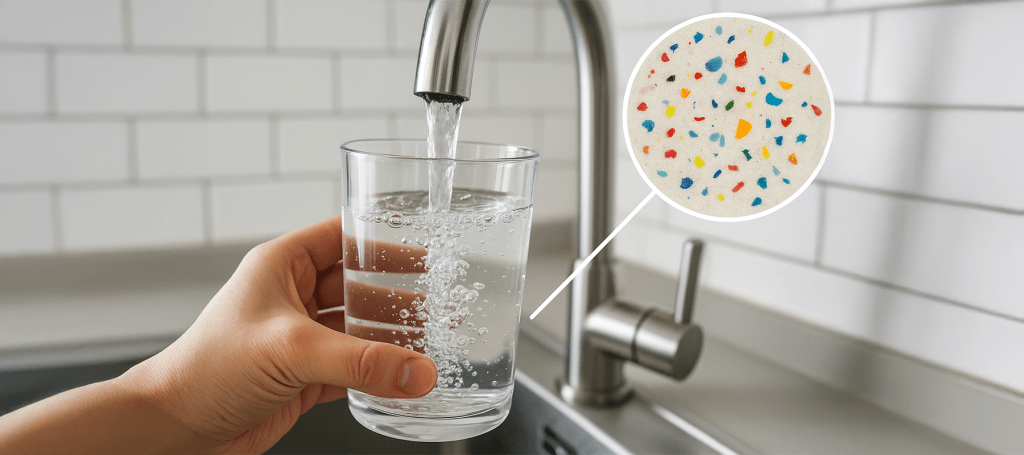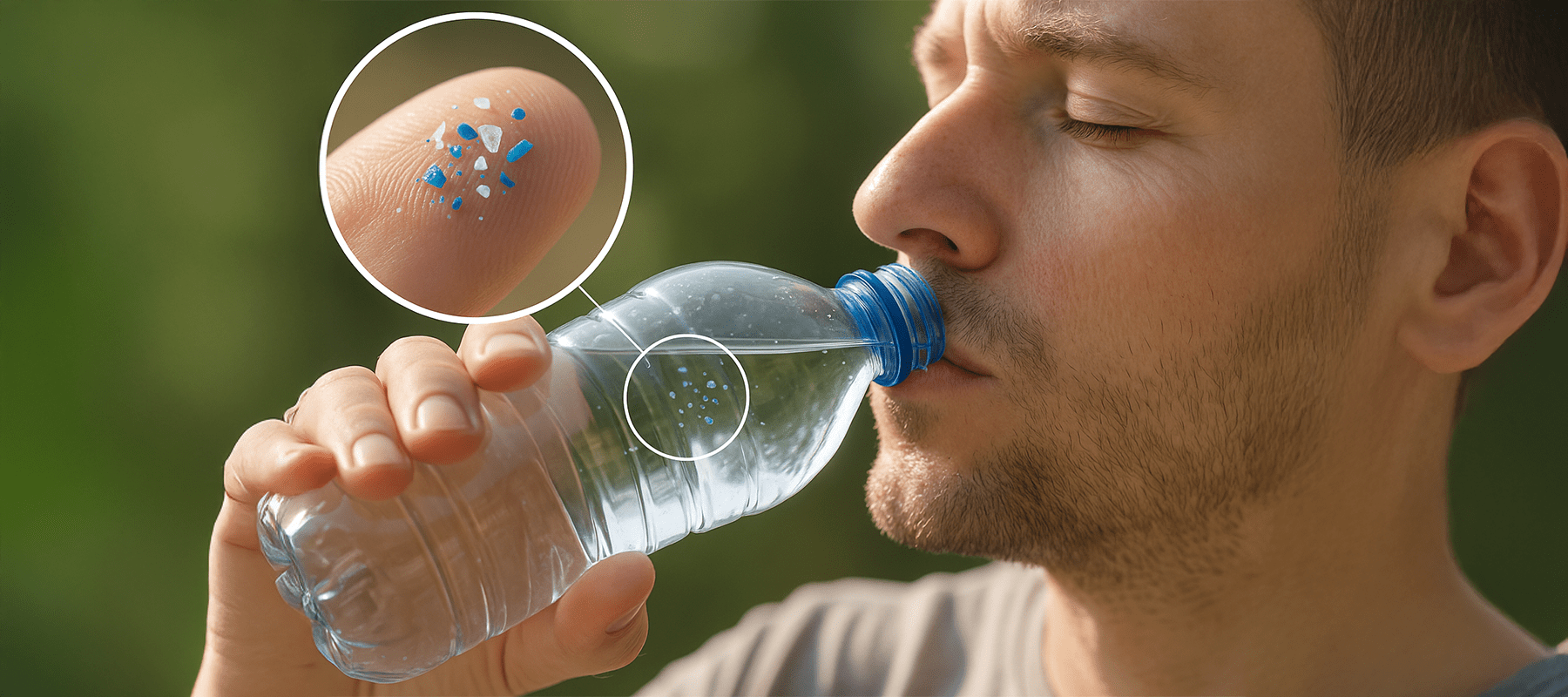I used to take my tap water for granted, just like a lot of you. It served as the base for my morning coffee, a cool glass after a run, and the water I used to keep my family hydrated. It appeared to be immaculate and was always present. That is, until a thorough examination of some genuinely disturbing but little-known scientific studies revealed an unseen danger: microplastics’ health in the USA.
This is about more than just small pieces of plastic; it’s about a serious public health issue, specifically the subtle dangers of endocrine disruption caused by microplastics in the US. It has been enlightening for me to go from ignorance to informed advocacy. Through US microplastics filtration policies, I hope to clarify a complicated problem and provide insight into possible solutions.
Does US Tap Water Contain Evidence of Endocrine Disruption from Microplastics? Breaking Down the Research
At the center of this debate is the question, “Is there evidence of endocrine disruption from microplastics in US tap water?” and the answer is becoming more and more emphatic in the affirmative. The precise effect that ingested microplastics have on our hormonal systems is frequently overlooked, despite the general public’s vague awareness of plastic pollution. Although they are still in the early stages of development, recent findings suggest alarming connections.
Think about my personal experience: I started to notice minor changes in my health, such as minor hormonal imbalances and unexplained fatigue. Was it simply getting older? Or something more widespread? A possible solution was offered by the scientific literature. Microplastics are not inert, according to studies, some of which were conducted in the last few years. They may serve as conduits for dangerous substances that seep into our bodies, such as bisphenol A (BPA) and phthalates, which are well-known endocrine-disrupting chemicals (EDCs).
As they decompose, plastics themselves may release additives and monomers that can disrupt hormones. Though frequently conducted on animal models, in vitro and in vivo studies demonstrate how these particles can disrupt hormone synthesis, transport, metabolism, and receptor binding, proving that this is more than just theory. This demonstrates just how dangerous tap water microplastics are.
What Impact Do Microplastics Have on American Human Health, Particularly Endocrine Function?
Understanding the intricate mechanism of microplastics’ endocrine disruption in the US is crucial. A delicate symphony of hormones, our endocrine system controls everything from mood and reproduction to growth and metabolism. This symphony can be upset when microplastics that contain or release EDCs get into our bodies through tap water. Consider small pieces of plastic that resemble keys and attempt to fit into the incorrect locks or prevent the proper keys from operating. Reproductive troubles, developmental disorders, metabolic diseases, and even some types of cancer can result from this interference.
A recurring pattern emerged from my own analysis of several scientific publications, some of which were published in journals such as Water Research and Environmental Science & Technology. The mechanistic evidence from cellular and animal studies is strong, even though direct epidemiological studies on humans that link the risks of tap water microplastics to particular endocrine diseases are difficult and still in progress.
It implies that long-term, low-level exposure—for example, from tainted tap water—may have significant, compounding effects. In the USA, this is a crucial area of microplastic health that needs greater focus.
What are the Public Health Consequences and the Frequency of Microplastics in American Tap Water?
Unfortunately, tap water in the United States is contaminated with microplastics. 94% of tap water samples in the United States, including samples from the Trump Tower and the U.S. Capitol, contained microplastic fibers, according to a groundbreaking 2017 study by Orb Media. This pervasive contamination is still supported by more recent studies. These microscopic intruders are present in everything from municipal supplies to bottled water.
The implications for public health are significant. This widespread exposure is a silent crisis because microplastics have the potential to disrupt hormones in the United States. Pregnant women and children are especially at risk because of their developing systems. As a country, we must address the serious health issue caused by the cumulative load of EDCs from multiple sources, including our drinking water.
The current scientific consensus recognizes the potential for major health impacts from microplastics in the United States and advocates for a precautionary approach, even though it acknowledges the need for more human-specific data.

Which laws are being considered or put into effect in the United States to filter tap water for microplastics?
At this point, the discussion turns from the issue to possible fixes, concentrating on US microplastics filtration regulations. Microplastics in drinking water are not currently regulated by the U.S. Environmental Protection Agency (EPA). Given the new findings on the dangers of tap water microplastics, this regulatory gap is a serious worry.
Nonetheless, change is being pushed by the scientific and advocacy communities. Research supports my personal belief that we require a multifaceted strategy. This comprises:
However, advocacy and scientific communities are pushing for change. My personal opinion, backed by research, is that we need a multi-pronged approach. This includes:
1. Mandatory Monitoring:
Municipal water supplies must undergo routine, standardized microplastics testing.
2. Research Funding:
More money is being allocated to comprehending the long-term effects on human health, particularly regarding endocrine disruption.
3. Adoption of Filtration Technology:
Promoting and possibly requiring the use of cutting-edge filtration technologies at municipal treatment facilities. Microplastics can be effectively removed by technologies like reverse osmosis, nanofiltration, and ultrafiltration.
4. Point-of-Use Filters:
Increasing consumer knowledge of approved home filtration systems as a means of individual redemption.
Like other regulated pollutants, there is increasing debate about establishing maximum contaminant levels (MCLs) for microplastics. There is a small but encouraging trend toward comprehensive US microplastics filtration policies, as a number of states and municipalities are also starting to look into local solutions and pilot programs.
Taking Charge of My Tap Water: My Own Redemption
I couldn’t ignore the data after delving deeply into this research. My family’s health became my top concern, and I pushed for more significant change while looking for a personal solution. As a result of my review, I decided to purchase a top-notch whole-house filtration system that targets microplastics and other contaminants. Despite the slow pace of municipal action, I felt more at ease after taking charge of my immediate surroundings.
My conviction that we, as citizens and consumers, need to hold our government and water suppliers more accountable and transparent was strengthened by this experience. The scientific findings are unambiguous: microplastics pose a major threat to human health in the United States, especially when it comes to endocrine disruption. To safeguard our future, it’s time to put this knowledge into practice by implementing strong US microplastics filtration regulations.
Conclusion
A clear and immediate threat to public health is the underreported research on microplastics in US tap water, particularly with regard to endocrine disruption caused by microplastics in the US. The evidence is strong enough to demand immediate attention, even though the process of completely comprehending and reducing the risks associated with tap water microplastics is still ongoing.
We can all work together to ensure that the United States has better microplastics health in the future by encouraging more research, calling for regulatory action, and making educated decisions about our personal water filtration. Proactive policymaking and arming people with information and useful tools are the answers.

Rayan works closely with Eastpoint Digital, a reputed content marketing agency in California. He is dynamic in promoting and publishing blogs across various sites, focusing on generating quality backlinks to boost online visibility.














